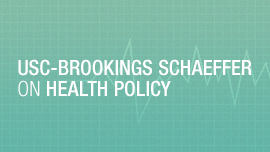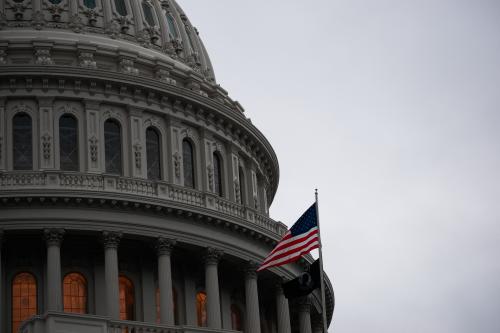This analysis is part of the USC-Brookings Schaeffer Initiative for Health Policy, which is a partnership between Economic Studies at Brookings and the University of Southern California Schaeffer Center for Health Policy & Economics. The Initiative aims to inform the national health care debate with rigorous, evidence-based analysis leading to practical recommendations using the collaborative strengths of USC and Brookings.
Surprise out-of-network bills arise when consumers receive care from an out-of-network provider in situations they cannot reasonably control. This includes emergency care as well as non-emergent ancillary services (like anesthesiology) received at an in-network facility from an out-of-network physician. As policymakers look to address this problem, network adequacy regulation is raised as a potential solution. This is natural: to-date, our primary tool to regulate provider networks has focused on network adequacy standards. However, standard network adequacy laws are designed to solve a different policy problem than surprise out-of-network billing, so it’s important to consider how the issues are related but distinct.
Network Adequacy Regulation
The modern era of network adequacy regulation dates to the mid-1990s. As insurance products began using selective provider networks, there was the potential for networks to be too small to provide access to care: if the network did not have sufficient providers offering a given service, then the consumer would not be able to access the services for which she was insured. To ensure access, state regulators began to adopt network adequacy standards that required each network plan to demonstrate that it had contracted with sufficient providers throughout its service area. In 1996, the National Association of Insurance Commissioners adopted its first Network Adequacy Model Act, which has formed the basis for most regulation since then.
Network adequacy should require insurers contract with enough providers to meet patients’ needs, but regulators should never require that insurers contract with every single provider in a given area, nor with any specific provider.
Importantly, the process of setting the numerical standards – of defining how many providers or facilities is sufficient for each specialty – has always been an extremely local process that responds to the density of providers in a given geographic area. This is for good reason: network adequacy should require insurers contract with enough providers to meet patients’ needs, but regulators should never require that insurers contract with every single provider in a given area, nor with any specific provider. If insurers were required to contract with a specific provider or all providers in an area, then those providers would be able to demand an unreasonable payment, since the insurer would not have the option to walk away from the negotiation.
Today, network adequacy standards are in place in all states for most insured products – though state laws vary in their stringency, the breadth of provider types to which they apply, and the degree of enforcement. With some exceptions, these laws generally do not apply to the facility-based provider types where surprise out-of-network bills can arise. Exchanges (including the Federally-Facilitated Marketplace) must certify that plans have adequate networks, but that process defers to existing state law. Self-insured employer plans are subject to no network adequacy standards.[1]
Surprise Billing and Network Adequacy
The network adequacy framework is poorly suited to addressing the problem of surprise out-of-network billing. Network adequacy policies are deliberately agnostic about which provider is in-network; the laws are not intended to guarantee that a particular clinician is in-network, but rather to ensure that consumers can access the services their insurance plan purports to cover. The idea is that when a patient is in need of a particular service, he can choose a provider to meet his needs.
For a policy to insulate consumers from receiving surprise out-of-network bills, it needs to guarantee that a specific provider is in the network, but that’s the very opposite of how network adequacy laws should operate.
However, the surprise out-of-network billing problem is defined by patients not having a choice of provider. From the patient’s perspective, it does not much matter whether the health plan has some anesthesiologists in the network, it only matters whether the anesthesiologist who happens to be on call the morning of your surgery is in-network. For a policy to insulate consumers from receiving surprise out-of-network bills, it needs to guarantee that a specific provider is in the network, but that’s the very opposite of how network adequacy laws should operate. To be sure, bringing marginally more providers in-network could make it somewhat less likely that a person receives a surprise bill, simply by reducing the number of potential out-of-network providers. The available data is consistent with this view: surprise out-of-network bills appear to be slightly less common in employer market compared to the Marketplace (23 percent versus 19 percent), where networks are generally narrower, but network size seems to explain only a small fraction of the surprise billing problem.
Put another way, a network adequacy standard for facility-based clinicians would not do anything to address the market failure that leads to surprise out-of-network billing. Network adequacy regulation would strengthen the incentive for insurers to bring these providers into their networks, but surprise bills arise because of the incentives that providers (not insurers) face. Ancillary and emergency providers are guaranteed a flow of patients without regard to their network status and therefore have a lucrative opportunity to remain out-of-network that is not available to their peer physicians in other specialties. Intensifying the pressure on insurers to contract with them would not change their ability to remain out-of-network; it would simply enable them to obtain even higher rates for going in-network – their current in-network rates in relation to Medicare are already extremely high – and would continue to leave consumers exposed.
Policies To Address the Market Failure
While network adequacy has been the primary regulatory tool for insurance networks, the rules generally only apply to a few types of facilities and providers. Indeed, we have network adequacy standards for hospitals and OBGYNs, but we do not think about needing separate network adequacy rules for nurses or ultrasound technicians. The proper tools to address surprise out-of-network billing solve the market failure by relying on the fact that – as in the case of the ultrasound technician and the nurse – the relevant market negotiation is between the ancillary or emergency provider and the facility in which they practice.
One approach, which we refer to as “billing regulation”, (1) establishes a minimum rate for out-of-network services that insurers are required to pay to providers, (2) prohibits balance billing by the provider above the insurer-paid amount, and (3) requires insurers treat the cost-sharing as in-network for the consumer. By prohibiting balance billing, such a policy directly addresses the market failure that today allows emergency and ancillary providers to receive a flow of patients that they can bill at any amount they choose. And the minimum payment rate and requirement that the insurer treat cost-sharing as in-network mean that consumers are indifferent about the network status of these providers. As a result, consumers have access to the needed care, addressing the same issue that network adequacy policies are meant to tackle in other contexts.
As a result [of solutions relying on a payment standard], consumers have access to the needed care, addressing the same issue that network adequacy policies are meant to tackle in other contexts
Another approach – which we call “contracting regulation” and is sometimes referred to as “bundling” – simply prohibits facility-based emergency and ancillary providers from billing separately to insurers or patients. Instead, they would receive payment directly from the facility. Emergency and ancillary providers would negotiate a market rate for their services with the facility in which they practice. This guarantees patients that their particular clinician’s services will be treated as in-network when they seek care at an in-network facility, since all the services will be billed by the facility. Further, this approach effectively applies network adequacy policies to these clinicians by subsuming the emergency and ancillary clinicians within whatever network adequacy standards apply for hospitals (or other facilities) in the relevant market. That is, in order to bring the hospital into its network and to meet hospital network adequacy standards, the insurer would need to pay the hospital an adequate rate for the payments it will make to the ancillary and emergency physicians.
This is not to say that network adequacy policies cannot play a role in ensuring the market is fair for all participants. Our two approaches to solving the market failure for facility-based emergency and ancillary services do not address the need for consumer protections for other types of services – such as hospitals themselves, or primary care physicians, or the major specialties that are not primarily hospital-based. For these other areas of medicine where surprise billing is not nearly as prevalent, network adequacy regulation remains an important consumer protection. Moreover, as we have suggested elsewhere, there are creative ways to approach network adequacy regulation that are better aligned with surprise billing protections. Doing so could correct for market failures more thoroughly while allowing market innovation to flourish.
Additional resources on surprise billing are available here.
[1] There is one narrow exception: in order to comply with the requirement to cover preventive services, plans, including self-insured plans, must have an adequate network for the service in question.
The Brookings Institution is committed to quality, independence, and impact.
We are supported by a diverse array of funders. In line with our values and policies, each Brookings publication represents the sole views of its author(s).














Commentary
The relationship between network adequacy and surprise billing
May 10, 2019